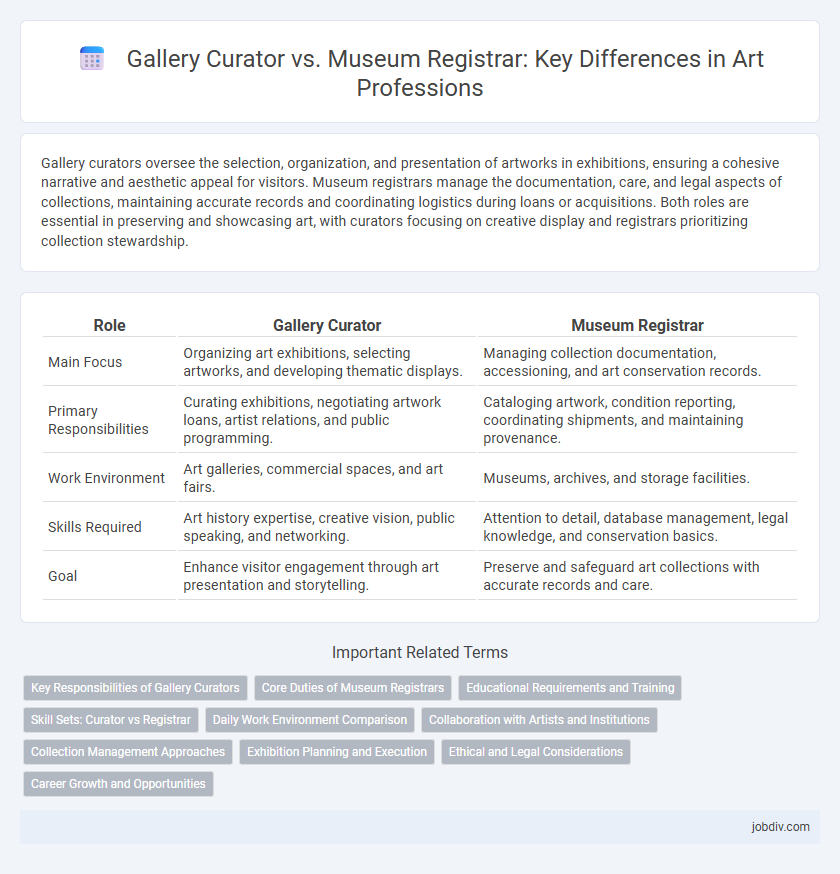Gallery curators oversee the selection, organization, and presentation of artworks in exhibitions, ensuring a cohesive narrative and aesthetic appeal for visitors. Museum registrars manage the documentation, care, and legal aspects of collections, maintaining accurate records and coordinating logistics during loans or acquisitions. Both roles are essential in preserving and showcasing art, with curators focusing on creative display and registrars prioritizing collection stewardship.
Table of Comparison
| Role | Gallery Curator | Museum Registrar |
|---|---|---|
| Main Focus | Organizing art exhibitions, selecting artworks, and developing thematic displays. | Managing collection documentation, accessioning, and art conservation records. |
| Primary Responsibilities | Curating exhibitions, negotiating artwork loans, artist relations, and public programming. | Cataloging artwork, condition reporting, coordinating shipments, and maintaining provenance. |
| Work Environment | Art galleries, commercial spaces, and art fairs. | Museums, archives, and storage facilities. |
| Skills Required | Art history expertise, creative vision, public speaking, and networking. | Attention to detail, database management, legal knowledge, and conservation basics. |
| Goal | Enhance visitor engagement through art presentation and storytelling. | Preserve and safeguard art collections with accurate records and care. |
Key Responsibilities of Gallery Curators
Gallery curators oversee the acquisition, exhibition, and interpretation of artworks, ensuring the collection aligns with the gallery's mission and audience engagement goals. They conduct research, collaborate with artists and lenders, and design exhibition layouts to enhance visitor experience and educational value. Their role demands expertise in art history, collection management, and public programming to maintain the gallery's cultural relevance and operational efficiency.
Core Duties of Museum Registrars
Museum registrars are responsible for the acquisition, documentation, and care of an institution's art collection, ensuring accurate records and provenance are maintained. Their core duties include managing inventory, coordinating loans, overseeing condition reports, and supervising the transportation and installation of artworks. These tasks ensure the preservation, legal compliance, and accessibility of the collection within the museum's operational framework.
Educational Requirements and Training
Gallery curators typically require a bachelor's or master's degree in art history, museum studies, or a related field, with specialized training in collection management and exhibition planning. Museum registrars often need a similar academic background but emphasize coursework or certifications in documentation, condition reporting, and legal aspects of art handling. Both roles benefit from internships or hands-on experience in galleries or museums to develop practical skills essential for art preservation and public engagement.
Skill Sets: Curator vs Registrar
Gallery Curators excel in art historical knowledge, exhibition design, and public engagement, focusing on selecting and interpreting artworks to create cohesive narratives. Museum Registrars specialize in collections management, emphasizing documentation, condition reporting, and logistics to ensure the preservation and legal compliance of artworks. Both roles require strong organizational skills, but curators prioritize creative vision and scholarly research while registrars focus on technical accuracy and risk management.
Daily Work Environment Comparison
Gallery curators manage exhibition planning, artwork acquisition, and artist relations, working in dynamic spaces filled with visitors and art installations. Museum registrars focus on the documentation, condition reporting, and safe transport of artworks within controlled environments, ensuring proper care and compliance with conservation standards. Both roles require close collaboration but differ in day-to-day tasks, with curators emphasizing creative presentation and registrars prioritizing logistical and preservation details.
Collaboration with Artists and Institutions
Gallery curators collaborate closely with artists to develop exhibitions and promote contemporary works, ensuring alignment with the gallery's vision and audience engagement. Museum registrars manage the documentation, condition reporting, and logistics of art pieces, facilitating smooth coordination between artists, lenders, and institutions. Their partnership guarantees the preservation, authenticity, and successful presentation of artworks within institutional collections.
Collection Management Approaches
Gallery curators emphasize the interpretive and educational aspects of collection management by selecting and organizing artworks to create cohesive, thematic exhibitions that engage audiences. Museum registrars focus on the meticulous documentation, condition reporting, and legal compliance necessary for preserving and tracking collections over time. Both roles collaborate to ensure collections are accessible, well-preserved, and aligned with institutional missions through complementary management approaches.
Exhibition Planning and Execution
Gallery curators oversee exhibition planning by selecting artworks, coordinating with artists, and designing thematic displays to engage audiences effectively. Museum registrars manage the logistical execution, ensuring proper documentation, condition reporting, transportation, and installation align with institutional standards. Collaboration between curators and registrars guarantees both creative vision and operational precision in successful art exhibitions.
Ethical and Legal Considerations
Gallery Curators ensure ethical stewardship by managing art collections with a focus on provenance research, cultural property laws, and artist rights, preventing illicit trade and unauthorized reproductions. Museum Registrars handle legal documentation, loan agreements, and condition reports to safeguard collection integrity while complying with international conventions such as the UNESCO 1970 Convention. Both roles demand adherence to professional codes of ethics established by organizations like the American Alliance of Museums to uphold transparency and accountability in art management.
Career Growth and Opportunities
Gallery curators often experience dynamic career growth through direct engagement with artists, exhibitions, and public programming, enabling them to develop specialized expertise and leadership in art curation. Museum registrars focus on collection management, provenance research, and conservation logistics, which provides opportunities to advance in collections care, compliance, and institutional administration. Both roles offer distinct pathways, with curators leaning towards creative and educational roles while registrars excel in operational and preservation-focused careers.
Gallery Curator vs Museum Registrar Infographic

 jobdiv.com
jobdiv.com